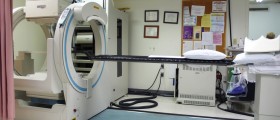Lumpectomy is a surgical procedure in which a tumor together with a small portion of surrounding tissue of the breast is removed. The resected part is then pathologically examined to determine whether the lump is malignant or benign. Together with a lumpectomy surgeon conducts a sentinel lymph node biopsy in order to make first-line lymph nodes visible and remove them together with the lump if necessary.
Lumpectomy is also known as a partial mastectomy, wedge resection, breast conserving therapy, wide excision biopsy, and segmental excision. Earlier the cancer was surgically treated with radical mastectomy (complete removal of the breast tissue together with the tumor and sometimes surrounding tissue such as muscles).

Who Cannot Undergo Lumpectomy
Nowadays some people still have to be treated with this method while others can undergo lumpectomy. Lumpectomy is not recommended for women who have multiple cancers in separate locations, have had a prior lumpectomy followed by radiotherapy, extensive cancers, problematic and large tumors (those which grow quickly or are attached to surrounding structures such as chest wall or skin), are pregnant, have preexisting diseases and those who have already undergone radiation treatment due to other malignant diseases (such as Hodgkin lymphoma).
How Lumpectomy is Performed
The procedure is conducted under general anesthesia. The tumor together with the surrounding tissue is removed. After that, the surgeon reconstructs the breast. If after conducting the sentinel node biopsy the first line lymph node which during the procedure resected is confirmed to have metastatic cells, the procedure extends to the axilla when its lymph nodes are resected as well. The drainage tube is inserted during the operation and it is removed afterward. The procedure takes a maximum of three hours.
Recovery Time
Recovery time starts in the recovery room where a patient spends minimum time. If they are kept in hospital they are released after a day or two, but most go home the same day. The patients have to follow the surgeon's instructions.
Painkillers are always prescribed and generally, the pain goes away after two or three days. What may help in pain reduction is an ice bag over the incision line. This can only be recommended by the doctor. Most women can continue their daily activities within two weeks but have to avoid lifting heavy objects with the arm on the operated side for a long period.
The doctor will probably suggest patient to wear the right size bra for a week after the surgery. What follows are regular check-ups when a doctor decides on the following treatment and therapy. If the tumor is proved to be a malignant standard scheme of postoperative chemotherapy and radiation are involved. These may be administered after healing is complete.
- Feedback from prior breast cancer survivors was obtained using a 19-question survey distributed online to multiple breast cancer support groups. It focused on issues relevant to choosing between the two surgical options including, post-surgical complications, breast reconstruction, chronic pain, cosmetics, and surgery-choice satisfaction.
- There were 978 mastectomy patients (60.9%) and 628 lumpectomy patients (39.1%). With regard to post-surgical reconstruction, 64.2% of mastectomy respondents and 13.5% of lumpectomy respondents decided to undergo breast cancer reconstruction following breast cancer surgery.
- Almost all (99.8%) of lumpectomy respondents had radiation side-effects; with skin irritation and thickening and chest wall tenderness being the most common. Among mastectomy patients, 94.3% had one or more complications; loss-or-changes in nipple or breast sensation, uneven breasts, chest wall tenderness, and breast swelling were the most common complications.
- Post-surgical pain lasting six months or more was experienced by a smaller percentage of mastectomy vs. lumpectomy patients (64.1% vs. 78%, p
- With respect to cosmetic outcomes, mastectomy patients vs. lumpectomy patients were less likely to be either satisfied or very satisfied (52.2% vs. 62.7%, p=0.00004). Overall satisfaction of surgical treatment was 70.9% for mastectomy patients and 68.6% for lumpectomy patients.

















Your thoughts on this
Loading...